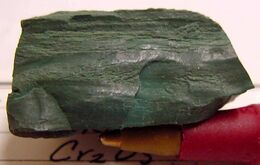Chemistry:Eskolaite
| Eskolaite | |
|---|---|
 Eskolaite from Russia | |
| General | |
| Category | Oxide mineral |
| Formula (repeating unit) | Cr2O3 |
| Strunz classification | 4.CB.05 |
| Crystal system | Trigonal |
| Crystal class | Hexagonal scalenohedral (3 m) H-M symbol: (3 2/m) |
| Space group | R3c, No. 167 |
| Unit cell | a = 4.95, c = 13.58 [Å]; Z = 6 |
| Identification | |
| Color | Black to dark green |
| Crystal habit | Hexagonal prisms and plates |
| Cleavage | None |
| Tenacity | Brittle |
| Mohs scale hardness | 8 – 8.5 |
| |re|er}} | Vitreous or metallic |
| Streak | Pale green |
| Diaphaneity | Opaque, translucent in thin edges |
| Specific gravity | 5.18 |
| Density | Measured: 5.18 g/cm3, Calculated: 5.20 g/cm3 |
| Optical properties | Uniaxial |
| Pleochroism | Noted; emerald-green to olive-green |
| References | [1][2][3] |
Eskolaite is a rare chromium oxide mineral (chromium(III) oxide Cr2O3).
Discovery and occurrence
It was first described in 1958 for an occurrence in the Outokumpu ore deposit of eastern Finland .[2] It occurs in chromium bearing tremolite skarns, metamorphosed quartzites and chlorite bearing veins in Finland; in glacial boulder clays in Ireland and in stream pebbles in the Merume River of Guyana.[1] It has also been recognized as a rare component in chondrite meteorites.[1]
The mineral is named after the Finnish geologist Pentti Eskola (1883–1964).
Structure and physical properties
Eskolaite crystallizes with trigonal symmetry in the space group R3c and has the lattice parameters a = 4.95 Å and c = 13.58 Å at standard conditions. The unit cell contains six formula units. The lattice is analogous to that of corundum, with Cr3+ replacing Al3+.
See also
References
- ↑ 1.0 1.1 1.2 Eskolaite in the Handbook of Mineralogy
- ↑ 2.0 2.1 Eskolaite on Mindat.org
- ↑ Eskolaite data on Webmineral.com
- ↑ Warr, L.N. (2021). "IMA–CNMNC approved mineral symbols". Mineralogical Magazine 85 (3): 291–320. doi:10.1180/mgm.2021.43. Bibcode: 2021MinM...85..291W.
 |


